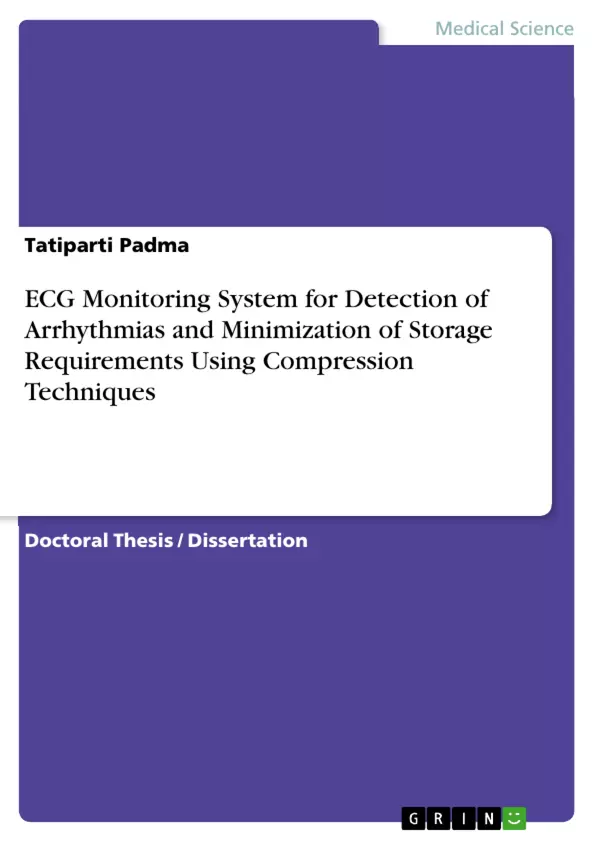The main purpose of the present work is to design and implement a prototype ECG system with wireless links for continuous monitoring of the subject for cardiac related problems. The ECG signal acquired from subject is filtered, digitized, and compressed for wireless communication. The proposed system can be extended, upon interfacing with other devices, for continuous monitoring of other vital parameters of the patient.
In automation of the ECG signal analysis, the workload of the medical professionals can be reduced. The automated system provides an alert when critical changes are detected by the system. Concisely stated, ECG of the patient is continuously monitored and deviations from normalcy are detected in real-time. The changes in the ECG could
be due to heart attack, fibrillation or arrhythmias. In case of emergency, data is transmitted to a medical practitioner, who in turn can provide necessary directions to take care of the situation. In this manner, as the problems can be detected as and when they occur, the remedial actions are initiated before the problems become serious.
The complete ECG diagnostic system includes a low power Instrumentation amplifier, filters, ADC, Microcontroller and ZIGBEE modules. MATLAB / LABVIEW are used for signal analysis and classification. These environments are capable of not only collecting, recording, transmitting, and displaying ECG data on a real time basis but also for analyzing the acquired ECG data in order to detect the cardiac abnormalities.
The MIT-BIH database signals were used for validation and evaluation of classification algorithms. In order to reduce the memory requirements for storing the acquired ECG signals, ECG data was compressed. Discrete Cosine Transform (DCT) technique was applied for ECG data compression. Here DCT showed good performance with a Compression Ratio (CR) of 82-90.43% and Percent Root Mean Difference (PRD) of 7.9-0.93. Linear Vector Quantization method (LVQ)
is used for identifying the abnormalities associated with the ECG signal. After training the LVQ process with a reasonable number of samples, the algorithm is used for classifying ECG signals. The techniques used in the present work for ECG signal compression and classification gave better results compared to those found in the literature.
Inhaltsverzeichnis (Table of Contents)
-
Abstract
-
List of Figures
-
List of Tables
-
Chapter 1: Introduction
-
1.1 Introduction
-
1.2 Background of ECG Monitoring
-
1.3 Objective of the Thesis
-
1.4 Thesis Organization
-
-
Chapter 2: Literature Survey
-
2.1 Overview of ECG and its Applications
-
2.2 ECG Signal Compression Techniques
-
2.3 Wireless ECG Monitoring Systems
-
-
Chapter 3: System Design and Implementation
-
3.1 Hardware Design
-
3.2 Software Design
-
3.3 ECG Signal Acquisition and Processing
-
3.4 Compression Algorithm
-
3.5 Wireless Transmission
-
3.6 System Integration and Testing
-
-
Chapter 4: Performance Evaluation
-
4.1 Compression Performance Evaluation
-
4.2 System Performance Evaluation
-
-
Chapter 5: Conclusion and Future Work
Zielsetzung und Themenschwerpunkte (Objectives and Key Themes)
This thesis aims to design and develop a wireless ECG monitoring system that incorporates compression techniques to reduce the storage requirements of the captured ECG data. The focus is on providing continuous monitoring for cardiac health while minimizing the burden of data storage and transmission.
- Continuous ECG Monitoring
- ECG Signal Compression
- Wireless Transmission
- System Performance Evaluation
- Application in Cardiac Health Management
Zusammenfassung der Kapitel (Chapter Summaries)
Chapter 1: Introduction
This chapter introduces the concept of ECG monitoring and its significance in identifying cardiac abnormalities. It highlights the objective of the thesis, which is to design a wireless ECG system with compression capabilities. The chapter also outlines the organization of the thesis.
Chapter 2: Literature Survey
This chapter provides a comprehensive review of existing research on ECG monitoring, signal compression techniques, and wireless ECG systems. It explores various approaches and technologies used in the field.
Chapter 3: System Design and Implementation
This chapter delves into the detailed design and implementation of the proposed wireless ECG monitoring system. It covers the hardware design, software design, ECG signal acquisition and processing, compression algorithm, wireless transmission, and system integration and testing.
Chapter 4: Performance Evaluation
This chapter presents the performance evaluation of the developed system. It analyzes the compression performance of the chosen algorithm and assesses the overall system performance in terms of accuracy, efficiency, and reliability.
Schlüsselwörter (Keywords)
ECG Monitoring, Arrhythmia Detection, Compression Techniques, Wireless Communication, Cardiac Health, System Design, Performance Evaluation.
- Arbeit zitieren
- Tatiparti Padma (Autor:in), 2014, ECG Monitoring System for Detection of Arrhythmias and Minimization of Storage Requirements Using Compression Techniques, München, GRIN Verlag, https://www.grin.com/document/1194504



